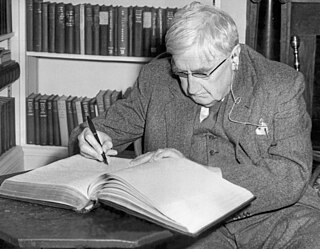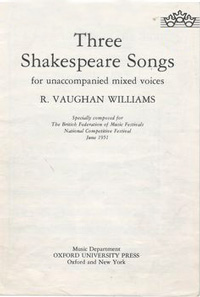
Ralph Vaughan Williams was an English composer. His works include operas, ballets, chamber music, secular and religious vocal pieces and orchestral compositions including nine symphonies, written over sixty years. Strongly influenced by Tudor music and English folk-song, his output marked a decisive break in British music from its German-dominated style of the 19th century.
Ralph Vaughan Williams wrote his Symphony No. 5 in D major between 1938 and 1943. In style it represents a shift away from the violent dissonance of his Fourth Symphony, and a return to the gentler style of the earlier Pastoral Symphony.

Fantasia on a Theme by Thomas Tallis, also known as the Tallis Fantasia, is a one-movement work for string orchestra by Ralph Vaughan Williams. The theme is by the 16th-century English composer Thomas Tallis. The Fantasia was first performed at Gloucester Cathedral as part of the 1910 Three Choirs Festival, and has entered the orchestral repertoire, with frequent concert performances and recordings by conductors and orchestras of various countries.

A Sea Symphony is an hour-long work for soprano, baritone, chorus and large orchestra written by Ralph Vaughan Williams between 1903 and 1909. The first and longest of his nine symphonies, it was first performed at the Leeds Festival in 1910 with the composer conducting, and its maturity belies the relatively young age – 30 – when he began sketching it. Moreover, it is one of the first symphonies in which a chorus is used throughout as an integral part of the texture and it helped set the stage for a new era of symphonic and choral music in Britain during the first half of the 20th century. It was never numbered.
Ralph Vaughan Williams dedicated his Symphony No. 4 in F minor to Arnold Bax.
Herbert Whitton Sumsion was an English musician who was organist of Gloucester Cathedral from 1928 to 1967. Through his leadership role with the Three Choirs Festival, Sumsion maintained close associations with major figures in England's 20th-century musical renaissance, including Edward Elgar, Herbert Howells, Gerald Finzi, and Ralph Vaughan Williams. Although Sumsion is known primarily as a cathedral musician, his professional career spanned more than 60 years and encompassed composing, conducting, performing, accompanying, and teaching. His compositions include works for choir and organ, as well as lesser-known chamber and orchestral works.
Sinfonia antartica is the Italian title given by Ralph Vaughan Williams to his seventh symphony, first performed in 1953. It drew on incidental music the composer had written for the 1948 film Scott of the Antarctic.
English Folk Song Suite is one of English composer Ralph Vaughan Williams' most famous works. It was first published for the military band as Folk Song Suite and its premiere was given at Kneller Hall on 4 July 1923, conducted by Lt Hector Adkins. The piece was then arranged for full orchestra in 1924 by Vaughan Williams' student Gordon Jacob and published as English Folk Song Suite. The piece was later arranged for British-style brass band in 1956 by Frank Wright and published as English Folk Songs Suite. All three versions were published by Boosey & Hawkes; note the use of three different titles for the three different versions. The suite uses the melodies of nine English folk songs, six of which were drawn from the collection made by Vaughan Williams' friend and colleague Cecil Sharp.

Crown Imperial is an orchestral march by William Walton, commissioned for the coronation of King George VI in Westminster Abbey in 1937. It is in the Pomp and Circumstance tradition, with a brisk opening contrasting with a broad middle section, leading to a resounding conclusion. The work has been heard at subsequent state occasions in the Abbey: the coronation of Queen Elizabeth II in 1953, the wedding of Prince William in 2011 and the coronation of King Charles III in 2023. It has been recorded in its original orchestral form and in arrangements for organ, military band and brass band.
Ralph Vaughan Williams's Symphony No. 3, published as A Pastoral Symphony and not numbered until later, was completed in 1922. Vaughan Williams's inspiration to write this symphony came during World War I after hearing a bugler practising and accidentally playing an interval of a seventh instead of an octave; this ultimately led to the trumpet cadenza in the second movement.

In the Fen Country is an orchestral tone poem written by the English composer Ralph Vaughan Williams. Vaughan Williams had completed the first version of the work in April 1904. He subsequently revised the work in 1905 and 1907. It is Vaughan Williams' earliest composition not to be withdrawn.

Ralph Vaughan Williams's Symphony No. 8 in D minor was composed between 1953 and 1955. Sir John Barbirolli, its dedicatee, conducted the Hallé Orchestra in the premiere at the Kings Hall in Manchester, on 2 May 1956. It is the shortest of the composer's nine symphonies, and is mostly buoyant and optimistic in tone.

The Symphony No. 9 in E minor was the last symphony written by the English composer Ralph Vaughan Williams. He composed it during 1956 and 1957, and it was given its premiere performance in London by the Royal Philharmonic Orchestra conducted by Sir Malcolm Sargent on 2 April 1958, in the composer's eighty-sixth year. The work was received respectfully but, at first, without great enthusiasm. Its reputation has subsequently grown, and the symphony has entered the repertoire, in the concert hall and on record, with the majority of recordings from the 1990s and the 21st century.

Job: A Masque for Dancing is a one-act ballet produced in 1931. The scenario is by Geoffrey Keynes, the choreography by Ninette de Valois, and the music by Ralph Vaughan Williams. The ballet is based on the Book of Job from the Hebrew Bible and was inspired by the illustrated edition by William Blake. The music was first given in concert in 1930 and the ballet had its stage premiere on 5 July 1931. It was the first ballet to be produced by an entirely British creative team. It was taken into the repertoire of the Vic-Wells Ballet and its successors, and has been intermittently revived.
The Concerto in A minor for Oboe and Strings was written by Ralph Vaughan Williams in 1943–44 for the oboist Léon Goossens, to whom the score is dedicated.

Three Shakespeare Songs is a piece of classical choral music written for an a cappella SATB choir. It was written in 1951 by the British classical composer Ralph Vaughan Williams. The work comprises three short pieces which are settings of text from two plays by the English playwright William Shakespeare. It is published by Oxford University Press.
The Magnificat is a Christian canticle found in the Gospel of Luke.
Ralph Vaughan Williams' Four Last Songs cycle is made up of four songs: "Procris", "Tired", "Hands, Eyes, and Heart", and "Menelaus". All of the songs were composed between 1954 and 1958. The cycle is best suited for mezzo-soprano, although, the original program note from the cycle's 1959 premiere acknowledges that all of the songs may be sung by a baritone, except for "Hands, Eyes, and Heart", "which is a woman's song." It is suggested that the four songs were originally intended to be two separate song cycles with "Menelaus" and "Procris" belonging to one cycle and "Tired" and "Hands, Eyes, and Heart" belonging to another. However, there is debate in the scholarly community about this proposed song cycle grouping. Renée Chérie Clark in her essay, "A Critical Appraisal of Four Last Songs" suggests, citing a letter from the composer to a friend at Cornell University, that Vaughan Williams actually intended for "Menelaus" and "Hands, Eyes, and Heart" to be grouped together. The composer's death in 1958 left both cycles unfinished, and in 1960, they were assembled by the composer's widow, Ursula Vaughan Williams, and published as set by Oxford University Press. The texts of all four songs are poems written by Vaughan Williams' wife Ursula who penned several books of poetry throughout her lifetime as well as a biography of her late husband. "Procris" and "Menelaus" deal with figures from ancient Greek and Roman mythology and epic poetry while "Tired" and "Hands, Eyes, and Heart" depict images of love between a husband and wife.

Byron Adams is an American musicologist, composer, and conductor.
This is a summary of 1948 in music in the United Kingdom.








